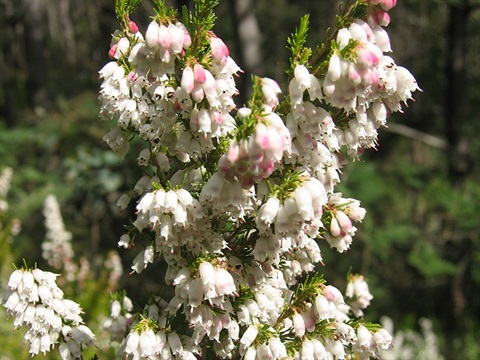Spanish Heath

Erica lusitanica
Origin: Western Europe
Size: 1m– 2m H, 0.5m–1.5m W
Best removal time: March to August
Seeds: October to January
Flowers: June to September
What it does
Spanish Heath invades areas of mid and ground storey, smothering and displacing indigenous groundcovers, herbs, grasses and orchids. It is very flammable.
What it looks like
Spanish Heath is an evergreen, slender erect woody shrub. It is often mistaken for the native Common Heath (Epacris impressa). The flowers are in pendulous clusters of 2-4 on the ends of very short side branchlets and vary from white to pinkish. Dead flowers persist on the plant before seeding in spring to early summer.
How it spreads
Each plant can produce 9 million seeds annually. They spread via:
- wind
- water
- animals
- contaminated soil
- spreading root systems
- dumping of garden plants
- sold at some nurseries, markets and fetes.
Removal
Remove by hand
Small plants can be hand pulled, larger plants can be dug out with a mattock or garden fork. Take care as plants break off easily and remaining roots will reshoot. Removal should be done before the plant seeds in spring.
Cut and paint
Larger plants can be cut off at the base and then the stump painted immediately with an undiluted glyphosate-based product.
Spray with herbicide
Use a registered product and ensure you check the label and follow instructions. This is best done in early autumn before flowering. Ensure not to overspray onto native vegetation. Ring the Department of Energy, Environment and Climate Action on 136 186 for full details.
Indigenous alternatives to plant
Many shrub alternatives exist that are indigenous to the Yarra Ranges region and would make great substitutes for the Spanish Heath. Some alternatives include:
How to dispose of weeds
By disposing of environmental weeds correctly you can prevent re-infestation on your property and elsewhere.
- Landfill (Weed Wipeout Tip vouchers available for some species).
- Green waste bins ensure that weeds are not able to spread.
- Woody weed stems can be bundled for green collection twice per annum.
- Composting (excluding seed heads or species with vegetative reproduction, e.g. Wandering Trad).
- Burning in accordance with Council and the Country Fire Authority (CFA) prescribed burning periods and regulations.
- Recovery and transfer stations available for weed tipping are Healesville, Wesburn, Coldstream, Lysterfield and Montrose.
Using chemicals
Non-chemical treatment is often the most effective and safe option especially on smaller scale infestations.
Where chemical use is undertaken:
- Always follow the manufacturer’s guidelines when using chemicals.
- Wear protective clothing and eyewear.
- When purchasing your herbicide, always ask for a Materials Safety Data Sheet (MSDS) or refer to the manufacturer’s website for specific safety guidelines and information.
- Some herbicides will kill other plants and not just the target species.
- When used near waterways herbicides can be very poisonous to aquatic life.
- Use chemicals sparingly and be sure that you are using the right chemical and application technique.
- Ensure the weather conditions are suitable (e.g. minimal wind and no rain expected).
- Apply herbicides at the correct time during the plant’s growth cycle so you get the best results.